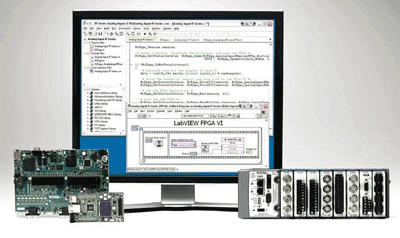Graphical engineering software aims to speed design innovation
With a name that reflects the adoption of an annual release cycle for significant enhancements, LabVIEW 2009 graphical system design software platform this year adds virtualization technology that simplifies development of parallel hardware architectures. The software not only takes better advantage of multicore systems than previously, but its new IP and compiler improvements enhances FPGA design. Further, the platform now lets users deploy code directly to wireless sensor networks and test multiple wireless standards including WLAN, WiMAX, GPS, and MIMO on one hardware platform. And it also streamlines algorithm design/deployment for real-time hardware.

The added virtualization technology lets users run multiple OSes side by side on a multicore processor. The software’s Real-Time Hypervisor combines its Real-Time Module capabilities with those of a general-purpose OS such as Windows XP to reduce system cost and size. Using this combo, engineers and scientists can run Windows XP and LabVIEW Real-Time side by side on a dual- or quad-core PXI controller, partitioning the processor cores among the operating systems for more efficient use of system resources.
For parallel-design needs as multicore programming and FPGA development, the platform offers a parallel for-loop structure, which automatically divides iterations of loops across multiple processors to increase the process’s execution speed. FPGA programming is further simplified with early compile feedback and critical-path highlighting to speed estimation of FPGA resource usage and to better debug timing violations. Additionally, streamlined FPGA IP delivers higher-throughput math and signal-processing performance.
Wireless sensor network designers can benefit from the platform’s WSN module, with its drag-and-drop programming environment for performing analysis and extracting and presenting measurement data. The Pioneer version of the module that is available now lets engineers and scientists program individual WSN measurement nodes to extend node battery life, increase acquisition performance, and create custom sensor interfaces.
Using virtual instrumentation and the software’s WLAN Measurement Suite, designers can deploy one software-configurable platform to acquire and analyze any modulation scheme or protocol standard, rather than using expensive, dedicated instruments for specific protocols. The suite guarantees compliance with IEEE 802.11 a/b/g standards and performs measurements more than five times faster than traditional instruments.
The MathScript RT Module gives engineers using text-based math tools access to real-time math for implementing and deploying algorithms used with deterministic OSs. The module also lets designers add their existing .m files and easily deploy them to RT hardware for faster system prototyping. (From $1,249 available now.)
National Instruments , Austin , TX
Ernest Martinez 800-258-7022
Advertisement
Learn more about National Instruments





